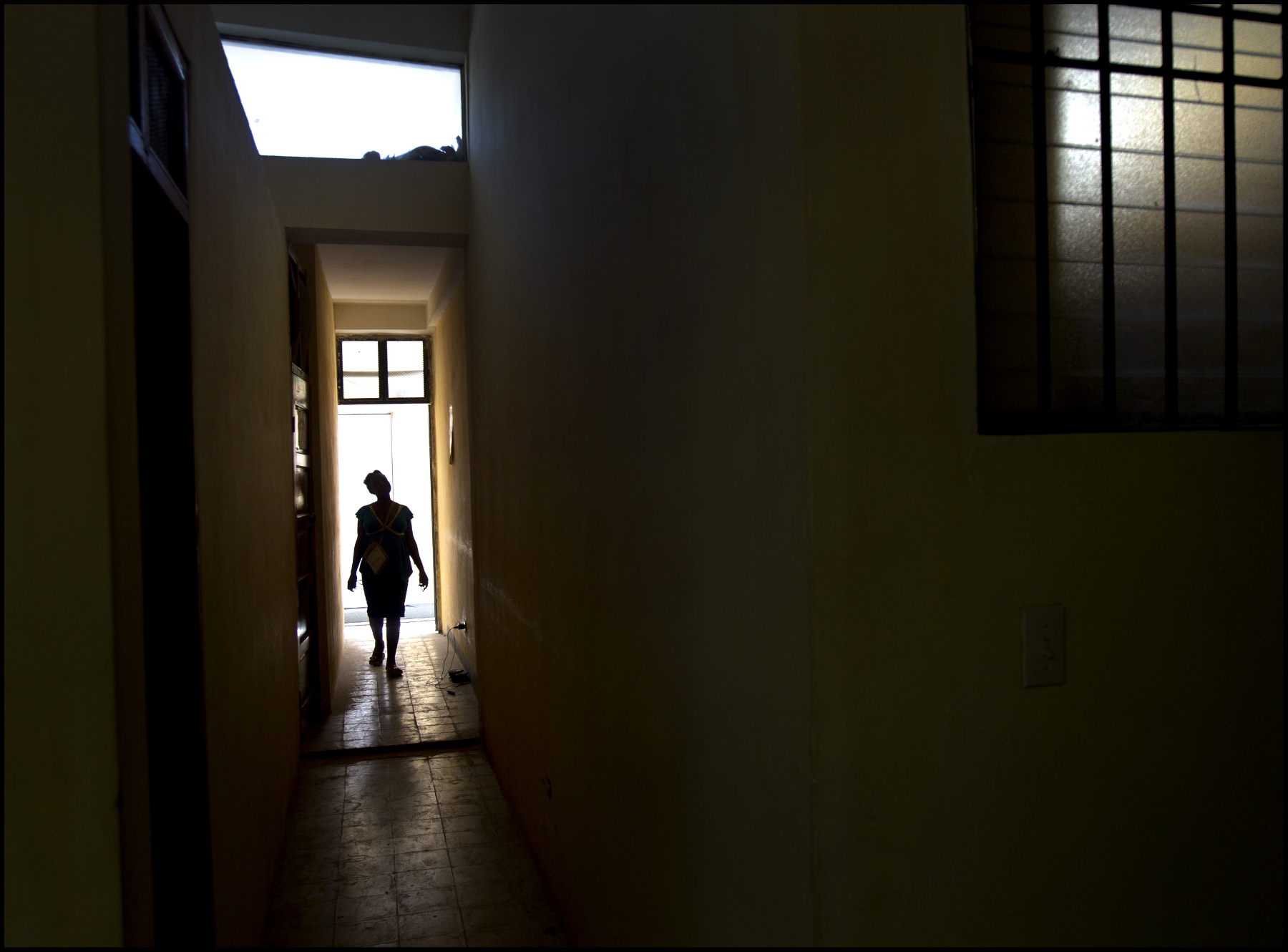
“There is No Abortion Here”
The Consequences of Unsafe Abortion
By Séverine Caluwaerts,
OBGYN, MPH,
with Catrin Schulte-Hillen,
Midwife, MPH

It was late at night when the staff called me to the hospital. Julie*, one of our colleagues, had arrived, bleeding severely and shivering with a high fever. She was lying on a blood-soaked bed and was white as a sheet.
Four days earlier Julie had come to me, begging for help. She was an excellent midwife. She worked beside me at an MSF project in what I will call Country A. We were always busy, and whenever she was in the labor ward, I knew she would take good care of the mothers and their babies.
She was only 24, but she seemed older and more mature. During breaks, we would drink tea and talk about our families and our work. She told me that she was supporting her three younger sisters so they could finish their studies.
I was completely unprepared one morning when Julie came to me in tears and whispered that she needed to see me privately. I poured her a cup of tea and she told me her story. For a few months she had been seeing a man who at first had not told her he had a wife and two children.
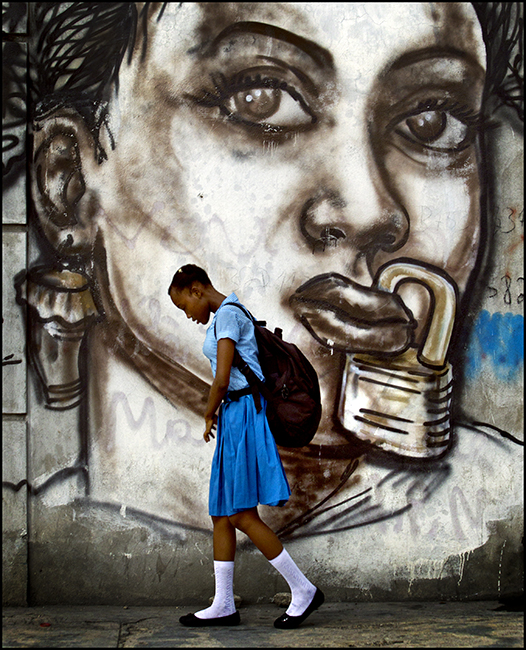
A student of a girls’ school in Port-au-Prince walks by a mural depicting the suppression of women in Haiti. Photo by Patrick Farrell
They had used condoms initially, but her partner preferred not to use them and contraception was not easy to get, especially for an unmarried woman. Since everyone knew everyone else in the community, it was difficult for Julie to go to the pharmacy to buy condoms or birth control pills. People would consider her promiscuous, a “bad girl.”
Like millions of women before and after her, Julie became pregnant at the wrong time with the wrong person. Hers was an unplanned pregnancy. She had told her partner two days earlier but had not heard back from him.
In Country A, religion has a strong influence on policy. An unmarried pregnant woman is looked at with a scorn that extends to her family and community.
“This is the worst thing that has ever happened to me, Dr. Séverine,” she told me. “I can never tell my family because it will bring so much shame upon them.”
Abortion is legally restricted in Julie’s country, even in the case of rape. The only legal exception for termination of pregnancy is to save the life of the mother. This is the case in 66 countries. In 71 others, the state has additional provisions for abortion if, for instance, they preserve the woman’s mental or physical health or are being sought for certain socioeconomic reasons. Fifty-six nations place no restrictions, while three ban it unconditionally and entirely.i
Our project in Country A had only recently opened. We had not yet assessed the possible repercussions for women, staff, and the project if we were to provide abortion care. We still needed to take into account what the community would say and whether it would affect our ability to work in the area. The broader political situation there was not stable. Our headquarters had therefore decided that we could not perform abortions.
Julie was crying. I told her: “I want to help you, but as you know we do not do abortions in this project.” I also asked if she had a trustworthy person in her life with whom she could discuss the situation.
“No,” she said, “you are the only one who can help me.”
Julie knew that MSF had the drug misoprostol, which is used to induce abortions, because we used it in that project to treat postpartum hemorrhages. She asked if there was any way I could get her some tablets, but I told her that I could not.
I struggled with this decision—my medical duty was to help her; I respected her decision to have an abortion for reasons of her own, and I wanted more than anything to do something for her, but doing what she asked in this case could have had severe repercussions for Julie and the project. MSF could have been expelled from the country, leaving it unable to help thousands of people in need. If we had been in another country in a calmer time and our headquarters had approved it, we could have provided the abortion ourselves or referred her to a safe provider, as we do in other places. But there were no safe referral options that we were aware of.
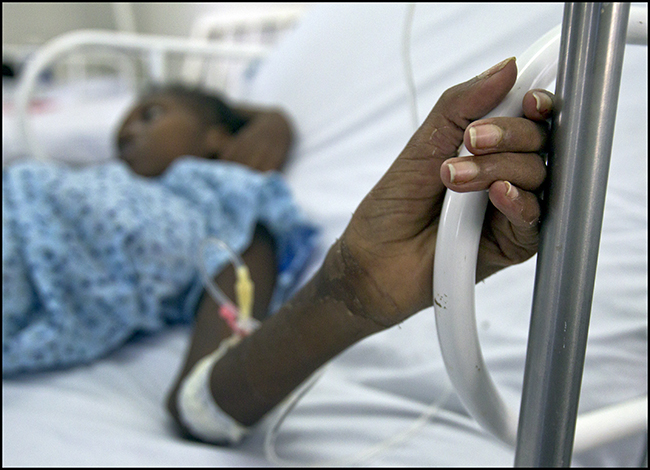
This 20-year-old girl arrived at MSF’s hospital for obstetrical emergencies in Port-au-Prince, suffering from a perforated uterus, excessive bleeding, and loss of fluids after an abortion performed by a non-licensed doctor, known locally as a “charlatan”. Photo by Patrick Farrell
Julie did not say anything else. I asked her to return in a week’s time and was hoping, in vain, that this unwanted pregnancy would perhaps become a miscarriage. I did not expect that when I saw her next I would be trying to save her life.
I examined Julie. Her cervix was open and foul-smelling contents were leaking out. She urgently needed a blood transfusion and antibiotics. Once they were administered, we brought her to the operating theater so we could remove the remaining septic matter.
With no other recourse, Julie had sought an abortion from someone with no medical training. I suspected that whoever performed the procedure had used a dirty rod to dilate her cervix in a crude attempt to induce the abortion. In doing so that person had put Julie’s life in jeopardy.
But Julie was lucky. She had a nearly fatal septic abortion but got treatment and recovered in a few days. I told her colleagues that she was admitted for a blood transfusion and antibiotics. I’m sure they suspected the unsafe abortion, but no one asked. Perhaps it was female solidarity; the other local midwives and staff certainly had daughters, sisters, or female friends who had been confronted with the same problem. To my knowledge, her partner did not visit her during her recovery.
Of the roughly 44 million abortions that occur every year,
around half are unsafe.
And these are just the cases that are reported.
The immediate, life-threatening complications from unsafe abortions are profuse bleeding, infection, and perforation of the uterus and adjoining organs. If the woman or girl survives, lifelong suffering, including chronic pelvic pain and infertility, can ensue. The human cost—suffering and often death—that women and girls bear alone at home after unsafe abortions is enormous, as is the suffering caused by the consequences of an unwanted pregnancy. Much of this cannot be measured with statistics.
But we do know that of the roughly 44 million abortions that occur every year, around half are unsafe, meaning they are performed by persons lacking the necessary skills or they take place in an environment lacking minimal medical standards, or both.ii These are only the abortions that are reported. The vast majority of unsafe abortions occur in developing countries in Africa and Latin America, as well as in China and Eastern Europe.iii
We also know that unsafe abortion is one of the five main causes of maternal mortality worldwide, together with hemorrhage, eclampsia, sepsis, and obstructed labor. Unsafe abortion accounts for a shocking 13 percent of maternal deaths around the world, according to the World Health Organization (WHO).iv The rates are even higher in certain regions, such as Latin America, and in contexts such as refugee camps and conflict areas.
There is a growing appreciation of the public health cost of managing the complications of unsafe abortion, a cost that is in economic terms much higher than the provision of safe abortion care.v The economics aren’t often considered, but they play an important role in the dynamics of abortion.
On the one hand, it costs more to treat women who’ve had unsafe abortions; on the other, there is a market for both safe and unsafe abortions in legally restricted environments. Those who benefit have little interest in changing the laws. Either way, abortion is provided whether or not it is legally restricted. And in most cases, the less money the patient has, the less likely she is to have a safe abortion.
Some countries have concluded that severe legal restrictions on abortion do nothing to stop demand, and that the resulting public health tragedies hit low-income women the hardest and cost public health systems the most. Six years after South Africa liberalized its abortion law, deaths from unsafe abortion dropped by at least half, and the number of post-abortion complications fell dramatically. Pregnancy-related deaths in Nepal also dropped when abortion was legalized in 2004. Hospitalizations and deaths from unsafe abortions ended almost immediately after the United States legalized abortion in 1973.vi
On a daily basis, MSF staff in hospitals
and emergency rooms the world over see women and girls with complications
from unsafe abortions get brought in for treatment.
This isn’t to say that legalizing abortion solves everything. Social norms do not change overnight, stigmas endure, and shortages of skilled professionals often remain.
MSF’s policy toward abortion is clear. We consider access to safe abortions to be a medical necessity—an important and lifesaving part of comprehensive reproductive health care that reduces maternal mortality and prevents unsafe abortions. In fact, unsafe abortion is the only cause of maternal mortality that is entirely preventable.
On a daily basis, MSF staff in hospitals and emergency rooms the world over see women and girls with complications from unsafe abortions brought in for treatment. They come in pain and are often ashamed, intimidated, and afraid of the staff’s reaction to what they’ve done. Some come bleeding and frightened; the person who sold them pills on the street or in a shop didn’t tell them what to expect when they tried to abort. For these patients, counseling, medical information, and discussion of future contraceptive options may be enough. Others arrive with life-threatening bleeding, severe infections, perforated uteruses, or in septic shock. They require immediate medical care, and sometimes surgical interventions and blood transfusions, to save their lives.
To be clear, MSF has no desire to perform abortions just for the sake of it. Rather, MSF wants to make sure women have access to safe abortions, carried out by trained medical staff, in order to keep women from the suffering and death that result from unsafe abortions. Ideally, unwanted pregnancies would be reduced, but that aim would depend on removing restrictions placed on the availability and discussion of contraception in many places. If Julie or others like her had been able to access a method of contraception that corresponded to her needs, she may not have gotten pregnant in the first place, and would not have then risked a procedure that nearly killed her.
During my time in Country A, many women came in following what I believed were unsafe abortions. Some were infected and near death. But when I asked, they always denied that they had tried to terminate their pregnancy. The stigma was too great.
This was in 2009; the project in Country A closed in 2013 and never did provide abortions because of security concerns. During that time, however, making safe abortion care available has increasingly become a priority for MSF.
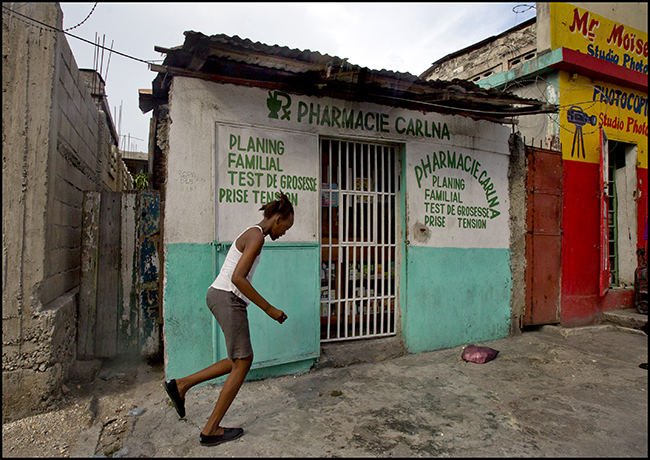
A young girl plays outside a typical pharmacy in downtown Port-au-Prince where misoprostol – a drug used to induce abortions – is readily available without prescription. Photo by Patrick Farrell
When I was the OBGYN in Bo, Sierra Leone, a 17-year-old girl named Fatmata was brought to the hospital. A schoolteacher had impregnated her. I was told that it was quite common for male teachers to molest or rape female students.
Fatmata told her mother and grandmother what had happened and the family decided together to go to a traditional birth attendant (TBA) to end the pregnancy and avoid the shame that would befall the family were she to carry the baby to full term. The TBA performed an unsafe abortion with an iron rod. The pregnancy was terminated, but the TBA also perforated the wall of Fatmata’s uterus and made a hole in the bowel, a common result of unsafe abortions.
By the time they reached the hospital, Fatmata’s mother thought her daughter was going to die. She had a fever of 102º F (39º C) and was suffering severe abdominal pain. An ultrasound revealed an infected mass of around 10 cm.
We gave Fatmata painkillers and antibiotics and referred her immediately to a project in the capital, Freetown, run by Emergency, an Italian NGO with very capable surgeons. They resected part of Fatmata’s bowel, but because her abdomen was so infected, they needed to perform a colostomy.
The result of this unsafe abortion was a 17-year old girl who had endured physical and emotional trauma and was left with a possibly permanent stoma. She may also have been rendered infertile. Even if she was not, any future pregnancies will come with a high risk of being ectopic (implanted outside of the uterus) and life-threatening.
The result of this unsafe abortion was a 17-year old girl
who had endured physical and emotional trauma and was left
with a possibly permanent stoma.
She may also have been rendered infertile.
Despite MSF’s clear policy that safe abortion should be integrated as part of reproductive health care in all contexts where it is relevant, MSF cannot provide abortions in every project for every patient who requests one. Few of our projects, in fact, provide termination of pregnancy on request. Doing so could endanger patients and staff, given the legal context and the communities’ perceptions of abortion in a given country. There are voices within MSF who want to reconsider this policy, however, and who stress that while weighing the risks to MSF personnel, we should also consider the risk facing the girl or woman—who we know will get an abortion one way or another.
Where MSF makes termination of pregnancy available, the staff will provide the service until the end of the first trimester. At a later gestational age, it is considered on a case-by-case basis. When a competent provider is accessible, we will refer patients to avoid duplicating services.
MSF’s treatment protocol favors medical abortion and manual vacuum aspiration. A medical abortion is the termination of pregnancy by administered drug. The combined use of mifepristone with misoprostol is effective in early pregnancy and is much less invasive than surgical procedures such as dilation and curettage (D&C) or vacuum aspiration. But it takes time. While D&C can only be performed by a physician in most countries, manual vacuum aspiration can be performed by other health staff, including midwives, and it is immediate. The choice of which procedure to use depends on the context and the medical condition of the patient. If all things are equal, the patient should be offered the choice.
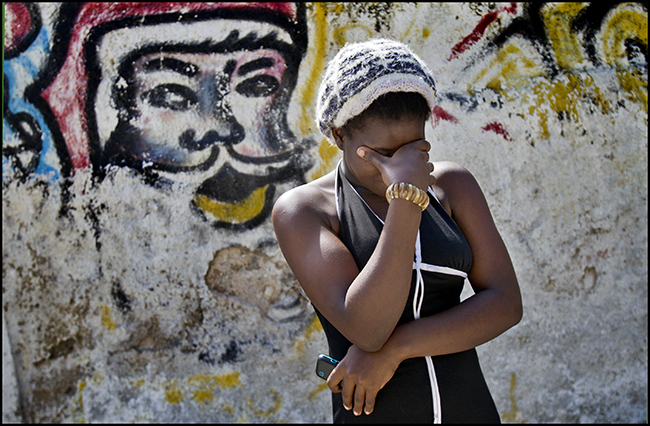
This 17-year-old girl from a rural town in Haiti became pregnant for the first time when she was
16. She says she has been repeatedly raped by a relative’s husband. She aborted the
pregnancy using misoprostol, purchased without a prescription. Photo by Patrick Farrell
Misoprostol has become more widely available on the private market in many countries. In fact, it’s a flourishing business for those who sell the drug where abortion is legally restricted. For girls and women in need of an abortion, it is much less dangerous than using a metal rod or the other dreadful tools of unsafe abortion. But misoprostol is still risky for a woman or girl without having a medical assessment and information on how to use the drug, what to expect after taking it, and what warning signs to look for. She also misses out on follow-up care, including contraception counseling and access to effective contraception for as long as she needs to suppress fertility.
At the Conference on Population and Development in Cairo two decades ago, the international community acknowledged the reality of maternal mortality and agreed that it could not be remedied unless contraceptives and safe abortion care were provided to women and girls, alongside safe obstetric care. Since then, much work has gone into providing or advocating for skilled obstetric care in developing countries, but the opposition remains adamant in the very countries where the highest numbers of women are dying from unsafe abortions.
“We do not have this problem,” I have been told.
“Our women are religious; there is no abortion done here.”
All the evidence points to the opposite conclusion.
Speaking with local health staffs, national health authorities, and political decision makers in many countries, I find they are generally sensitive to the medical arguments for the need to provide safe abortion care. But people frequently insist that unsafe abortions are something that does not happen in their community.
“We do not have this problem,” I have been told. “Our women are religious; there is no abortion done here.”
All the evidence points to the opposite conclusion: that women and girls will risk unsafe abortions to terminate unwanted pregnancies if no safe abortion care is available—even if they know the life-threatening risks, even if abortion is against the law, and even if community leaders deny that it is occurring. Julie was a midwife, after all. She knew the risks but took the chance because the alternative was unbearable for her and those around her.
If countries and communities are serious about reducing maternal mortality, there must be a realistic discussion about unwanted pregnancies. People should recognize that most women are denied control over their sexual lives, and there should be a commitment to change that—through easy access to contraception.
Abortion is obviously a charged subject, but from a medical perspective and from MSF’s work in emergency rooms around the world, it’s clear that the provision of safe abortion care to a woman or girl is a life-saving medical act. As long as access to safe abortion care is denied, more women and girls like Julie and Fatmata will continue to suffer, and many more women and girls will continue to die each year from the consequences of unsafe abortion.
*All patient and staff names have been changed.
iCenter for Reproductive Rights, “The World’s Abortion Laws Map”. Last modified September 17, 2014. http://reproductiverights.org/en/document/the-worlds-abortion-laws-map
iiSusan A. Cohen. “Access to Safe Abortion in the Developing World: Saving Lives While Advancing Rights.” Guttmacher Policy Review, 15, No. 3. Fall 2012. http://www.guttmacher.org/pubs/gpr/15/4/gpr150402.html
iiiWorld Health Organization (WHO), ”Unsafe Abortion: Global and Regional Estimates of the Incidence of Unsafe Abortion and Associated Mortality in 2008.” Sixth edition. P. 18-26. 2011. http://whqlibdoc.who.int/publications/2011/9789241501118_eng.pdf?ua=1
ivSneha Barot. “The Missing Link in Global Efforts to Improve Maternal Health.” Guttmacher Policy Review, 14, No. 2. Spring 2011. http://www.guttmacher.org/pubs/gpr/14/2/gpr140224.htm
vMichael Vlassoff, Damian Walker, Jessica Shearer, David Newlands and Susheela Singh. “Estimates of Health Care Systems Costs of Unsafe Abortion in Africa and Latin America.” Guttmacher Institute. 2009. http://www.guttmacher.org/pubs/journals/3511409.html


